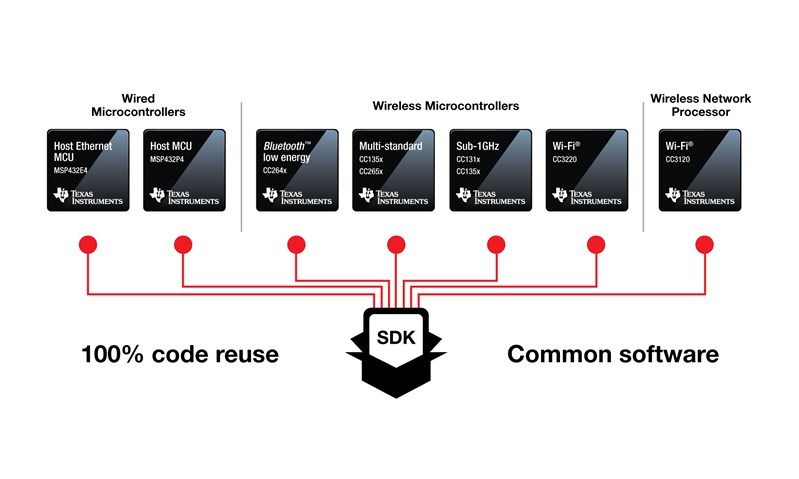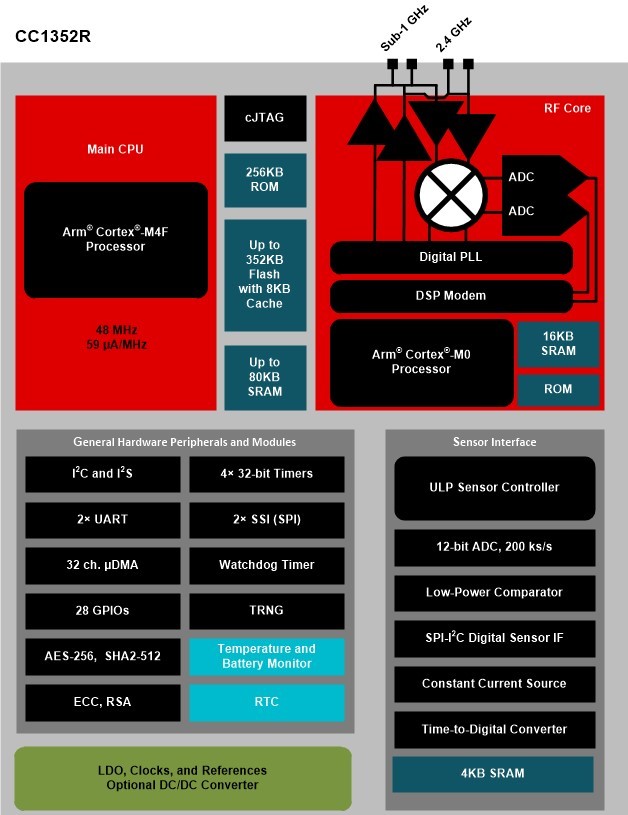SSZT781 february 2018 CC1312R , CC1352R , CC2642R , CC2652R

Imagine waking up, and using a voice command to turn on your lights and start your coffeemaker. As you leave for work, you use your smartphone to lock the door and arm your security system. While you’re away, you can remotely monitor intrusions, answer your doorbell and unlock your front door, all from a cloud dashboard. At work, a smart thermostat collects data from remote temperature sensors throughout the building and controls the climate in each individual room, saving energy and optimizing the environment for each user. Outside the office walls, thousands of messages fly through the air, reporting grid data from electric meters, water meters, streetlights and more.
This isn’t a science fiction movie – it’s today’s reality. Homes, buildings and cities are becoming more and more connected, but connectivity is hard, and as more devices become “smart,” design complexity continues to increase. Connected devices must be scalable and secure enough to keep up with the changing landscape while maintaining low power and high feature integration for long product lifetimes and expanded application coverage.
TI’s mission is to make connectivity easy for designers and developers with the SimpleLink™ microcontroller (MCU) platform, the largest portfolio of Arm®-based MCUs with 100% code compatibility between devices. Here is what you need to know about the newest devices in the SimpleLink platform:
- More connectivity
standards. When the SimpleLink platform launched, it supported Wi-Fi®,
Bluetooth® low energy, Sub-1 GHz, dual-band operation and host MCUs.
The newest SimpleLink devices add support for Thread, Zigbee and multistandard
(SimpleLink CC2652R), in addition to enhanced devices for Bluetooth 5
(SimpleLink CC2642R), Sub-1 GHz (SimpleLink CC1312R), multiband (SimpleLink
CC1352R) and host MCUs (SimpleLink MSP432P4). The breadth of connectivity
standards enables developers to create more scalable and future-proof products
to keep up with the demands of the connected landscape. Figure 1 shows the complete portfolio of SimpleLink devices.
 Figure 1 The Devices of
theSimpleLink MCU Platform
Figure 1 The Devices of
theSimpleLink MCU Platform - More design flexibility. With the addition of multiband and multistandard support on a single device (the SimpleLink CC1352R or CC2652R), design flexibility for applications continues to become more scalable. Through time-division multiplexing, you can take advantage of the benefits of multiple connectivity technologies using a single device. Leveraging SimpleLink software development kit (SDK) wireless plug-ins also enables a seamless transition between single- and multichip designs. Take, for instance, a smoke alarm system in a commercial building. The smoke alarm nodes can connect to the main security panel through a long-range Sub-1 GHz star network, taking advantage of the increased range and ability to penetrate walls. At the same time, it’s possible to turn the smoke alarms on or off, advertise their status, or perform upgrades or maintenance using a Bluetooth 5 connection with the user’s smart device.
- Lower power operation. The
new SimpleLink wireless devices have excellent power performance, with standby
current consumption as low as 0.8µA with 80KB of random access memory (RAM) and
central processing unit (CPU) retention. However, the key differentiator for
low-power operation is the sensor controller engine. The sensor controller is a
digital core with 4KB of RAM, which allows the main system to sleep until an
event trigger from sensor controller peripherals (12-bit analog-to-digital
converter [ADC], comparator, Serial Peripheral Interface [SPI]-I2C,
time-to-digital converter) wakes it up. For example, the sensor controller can
operate as low as 1µA while completing an ADC sample every second. This enables
connected devices to operate at ultra-low power while still monitoring sensor
data, which extends the lifetime of products that run on small coin-cell
batteries. Figure 2 is the full SimpleLink CC1352R wireless MCU block diagram.
 Figure 2 Block Diagram of
SimpleLink CC1352R Wireless MCU
Figure 2 Block Diagram of
SimpleLink CC1352R Wireless MCU - More integration. The newest SimpleLink platform wireless devices have an integrated Arm Cortex-M4F paired with 352KB of flash, 80KB of RAM and 256KB of read-only memory (ROM) with integrated components of protocols and firmware to optimize customer application space in flash. Additionally, the platform has the option for an integrated +20dBm power amplifier (PA) to enable higher power output for metering and building automation applications. The new SimpleLink devices also feature security enablers to make it easy to design secure applications. The devices include an Advanced Encryption Standard (AES)-128/AES-256 crypto accelerator, elliptic-curve cryptography (ECC) and a Rivest-Shamir-Adleman (RSA) public key hardware accelerator, a Secure Hash Algorithm (SHA) 2 accelerator (up to SHA-512), and a true random number generator. As more connected devices enter our homes, buildings and cities, these new features enable you to expand into more applications with greater integration and build secure applications to protect personal data.
- More hosting. The SimpleLink platform is expanding SimpleLink MSP432P4 host MCUs with the lowest-power 2MB MCU in order to manage multiple wireless communication stacks, human machine interfaces (HMIs) and firmware images. SimpleLink MSP432P4 MCUs are low-power 48MHz Arm Cortex-M4Fs with precision analog-to-digital converters (ADCs) including 16-bit performance, new enhanced lower-power peripherals and serial interfaces, a 320-segment liquid crystal display (LCD) and as many as 84 general-purpose input/output (GPIO) pins. In addition, these MCUs are completely pin-to-pin compatible with existing MSP432P4 products, enabling scalability from 128kB of flash all the way up to 2MB of flash and 256kB of static RAM. A suite of wireless plug-ins in the SimpleLink SDK makes pairing SimpleLink wireless MCUs to the SimpleLink MSP432 host MCU simple.
Additional Resources
- The SimpleLink multi-standard CC2652R wireless MCU (Thread, Zigbee, Bluetooth 5)
- Get started with the LAUNCXL-CC26X2R1 LaunchPad development kit and the CC26X2 SDK.
- The SimpleLink Bluetooth 5 CC2642R wireless MCU
- Get started with the LAUNCXL-CC26X2R1 LaunchPad development kit and the CC26X2 SDK.
- The SimpleLink Sub-1 GHZ CC1312R wireless MCU
- Get started with the LAUNCHXL-CC1312R1 LaunchPad development kit and the CC13x2 SDK.
- The SimpleLink multiband CC1352R wireless MCU (Sub-1 GHz + Bluetooth low energy, Thread, Zigbee)
- Get started with the LAUNCHXL-CC1352R1 LaunchPad development kit and the CC13x2 SDK.
- The SimpleLink MSP432P4 MCU (low power, precision ADC)
- Get started with the MSP-EXP432P4111 LaunchPad development kit and the MSP432 SDK.